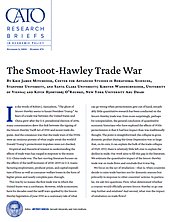Empirical and theoretical interest in understanding the effects of trade wars has surged in response to the recent U.S.-China trade war. The fast-moving literature focuses on the effects of the tariff increases of 2018–2019 on U.S. manufacturing employment, producer prices, and capital expenditure of firms as well as consumer welfare losses in the form of higher prices and nearly complete pass-through.
This was by no means the first trade war in which the United States was a combatant. However, while economists have for decades used the tariff wars sparked by the Smoot-Hawley legislation of June 1930 as a cautionary tale of what can go wrong when protectionism gets out of hand, remarkably little quantitative research has been conducted on the Smoot-Hawley trade war. Even more surprisingly, perhaps for nonspecialists, the general conclusion of quantitative economic historians who have explored the effects of 1930s protectionism is that it had less impact than was traditionally thought. The point is straightforward: the collapse in gross domestic product during the Great Depression was so large that, on its own, it can explain the bulk of the trade collapse of 1929–1933; there is relatively little left over to explain the decline in trade. Our work aims to fill this gap in the literature. We estimate the quantitative impact of the Smoot-Hawley trade war on trade flows and conclude that it was big.
We focus on the act of retaliation—that is, when countries decide to raise trade barriers not for domestic reasons but primarily in response to other countries’ actions. In particular, we ask two questions. First, what determined whether a country would officially protest Smoot-Hawley or go one step further and retaliate? And second, what was the impact of retaliation on trade flows?
Based on contemporary sources and government documents, we first identify country responses to Smoot-Hawley (whether they filed official protests with the U.S. government, retaliated by imposing tariffs, or simply did nothing). We then analyze whether these responses are predicted by trade or political relationships with the United States. Interestingly, we find that a country’s response to Smoot-Hawley is not determined by its pre-1930 share of exports or bilateral trade balance with the United States.
The main focus of our work, however, is on the effects of the Smoot-Hawley trade war on bilateral imports. We estimate these using a structural trade model and a new, hand-collected quarterly data set on bilateral trade for 99 countries during the interwar period. This is to our knowledge the first high-frequency bilateral data set to have been constructed for this period. These new quarterly data allow for more precise identification of the timing of the response to Smoot-Hawley. We focus particularly on the behavior of those countries that responded to Smoot-Hawley by filing official protests against Smoot-Hawley and/or imposing retaliatory tariffs against the United States. We employ our model estimates to compare these responders with U.S. trade partners that did not respond. This allows us to determine whether responders differentially reduced their imports from the United States after Smoot-Hawley, prima facie evidence that a trade war occurred.
Our results show that countries that responded to Smoot-Hawley with retaliatory tariffs reduced their imports from the United States by an average of 28–32 percent, while countries that protested the implementation of the Smoot-Hawley tariff also reduced their imports by 15–23 percent. In other words, de facto retaliation went beyond the group of countries commonly labeled as retaliators.
These findings raise an interesting question: how did responders succeed in targeting U.S. exports given that many were bound by their most-favored-nation obligations? One possible answer is that they used quotas, which are by their nature discriminatory, but another is that countries chose to raise tariffs strategically by targeting particularly important exports of the United States, such as automobiles. To test this hypothesis, we construct an additional new data set, this time of product-level quarterly U.S. exports to 59 countries between 1926 and 1932, and use our primary sources to identify key U.S. exports to each trade partner in 1928, before either the Great Depression or the trade war struck. Our model estimates show that retaliators significantly reduced their purchases of key U.S. exports, especially automobiles, after Smoot-Hawley passed. For example, even when controlling for aggregate U.S. exports to certain markets, we show that chief U.S. exports to retaliators were differentially affected, falling by an additional 33 percent after the United States raised tariffs in 1930—a result that is consistent with trade partners targeting goods that were particularly important to the United States. Our results also speak directly to the proposed mechanism driving the differential decline in U.S. exports during our sample period: retaliation by U.S. trade partners.
Finally, we calculate changes in the welfare gains from trade, following a recent approach that measures them using changes in the terms of trade. We find that the welfare gains from trade enjoyed by retaliators fell by roughly 8–16 percent and that the welfare gains for the United States were very small and mixed.
Note
This research brief is based on Kris James Mitchener, Kirsten Wandschneider, and Kevin Hjortshøj O’Rourke, “The Smoot-Hawley Trade War,” NBER Working Paper no. 28616, March 2021, http://www.nber.org/papers/w28616.




